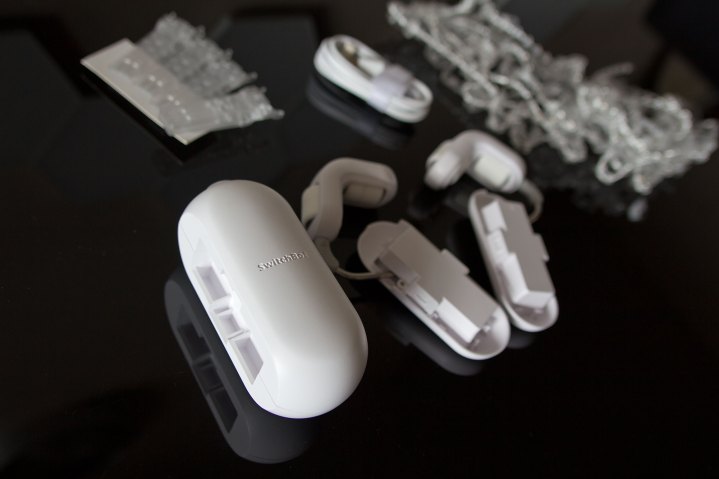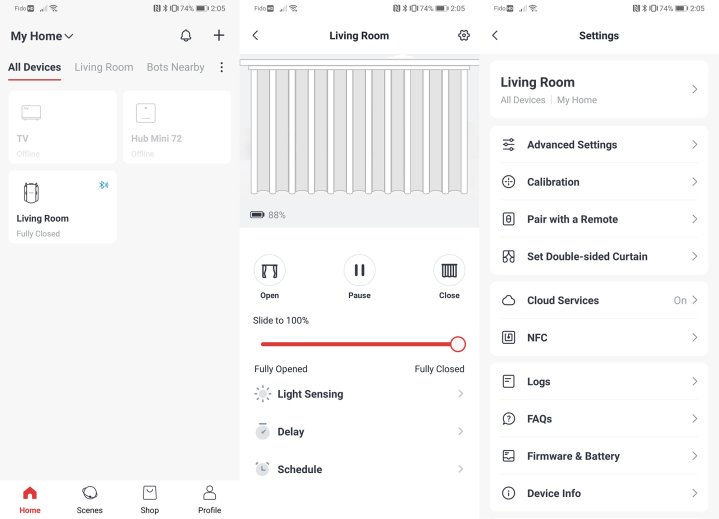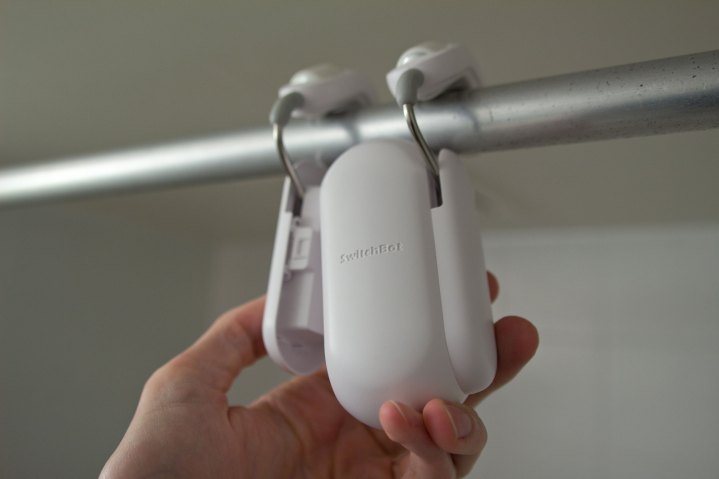“SwitchBot Curtain delivers mixed results for a questionable utility.”
- Smooth app
- Affordable
- Rich accessory ecosystem
- Easy installation
- Has HomeKit compatibility
- Noisy
- Unreliable performance
We’ve spent plenty of time looking at smart blinds, and SwitchBot is a name that routinely comes up. This company made a name for itself with a cute little robot that flips switches for you and has since expanded into just about every corner of home automation. They now make smart plugs, smart locks, and the SwitchBot Curtain. Is pulling a drawstring on your curtains so much work that we need yet another connected home doohickey to do it for us? Let’s find out!
Setup

The SwitchBot Curtain is available in four different varieties, depending on what kind of curtains you have. This system doesn’t work with vertical blinds, unfortunately, but SwitchBot provides detailed measurements to ensure your curtains are compatible before ordering. They also include some hardware to accommodate the bump in telescoping curtain rods.
Latching the SwitchBot Curtain onto your curtain rods is fairly straightforward. The hooks are removable and spring-loaded, so you can pull one hook up to catch the rod before snapping the second side onto the main body. It also has a simple LED and single button to help you through the Bluetooth pairing process. The mobile app it links to is generally straightforward, with helpful setup instructions. The room management portion is a little awkward; you can’t create rooms while adding devices. You can create rooms once the SwitchBot is set up, though. The app takes you through a simple calibration process that identifies the closed and open positions of your curtains. After that, it rolls to those positions with a single tap or allows for granular moving with a slider.
I ended up doing the bulk of my testing on a shower curtain.
My first run at setting up the SwitchBot Curtain did not go well. The curtains I worked with were well below the 17 pounds SwitchBot claims their units can push, and the rod was within the set diameter. Even after using the included clips and a string of clear beads to connect the length of the curtain to the SwitchBot, there still wasn’t enough traction to fully open them. If there was, that string would have still been an eyesore. I ended up doing the bulk of my testing on a shower curtain.
Features
Google Assistant, Siri, and Alexa compatibility are fairly high priorities. Alexa connected fine. Siri shortcuts work, though there was no love for wider Home support on Apple devices. Google Assistant wasn’t able to connect, despite using Google to create my SwitchBot account in the first place. If you want to get extra fancy with your automations, IFTTT is supported. When voice fails, NFC tags are supported as tap-and-go toggles. Android home screen widgets provide access a tap or two earlier, though iOS widgets are lacking the range to include SwitchBot Curtain.

The SwitchBot Curtain enjoys a growing ecosystem of supporting devices that can add a variety of conveniences. For example, SwitchBot sells a simple little button that can remotely activate the curtains as if you were doing it through the app. Though you typically connect to these curtains directly over Bluetooth, a separate hub can hop onto your Wi-Fi network and let you open and close them from the other side of the world if you wanted to do that (for some reason). That hub can also blast IR signals to other nearby devices like your TV, and make dumb appliances respond to voice commands. The most useful accessory for the SwitchBot Curtain is the solar panel, which can keep it charged without having to go through the work of unhooking it and plugging it in over USB-C. The battery is otherwise rated to last eight months between charges.
SwitchBot Curtain’s most useful feature out of the box is touch-and-go. You can tug the curtain, SwitchBot senses the shift, then it finishes the job of opening or closing. This is a very natural use case and provides full utility without having to fiddle with a mobile app.
SwitchBot Curtain’s most useful feature out of the box is touch-and-go.
The noise from the SwitchBot Curtain is a real issue. Say you come home and feel a little like Tony Stark. You casually say, “Alexa, open the living room curtains.” Before you have a chance to feel like we’re well and truly living in the future, your curtains screech with the high-pitched, belabored squeal. There are light sensing and scheduling options available, but I couldn’t imagine using them to open up my bedroom windows every morning and waking up to that racket. There’s a quiet mode tucked in the advanced settings, but toggling it doesn’t seem to make any difference. This noise problem undercuts a lot of the novelty value, even if the blinds do end up opening and closing hands-free.
Our take

SwitchBot Curtain delivers mixed results for a questionable utility. Sure, curtains can block the sun from heating up your house on a hot day, but physically pulling those curtains myself has never been a huge barrier. Ultimately, having fully automated curtains is a luxury, but it’s really hard to feel luxurious with such a noisy motor. If you’re going to bother, it’s worth the investment in a proper retrofit made by professionals to install a system that works consistently and is quiet. Products like SwitchBot Curtain catch the eye because they’re inexpensive and easy to install compared to full-blown window renovation.
How long should it last?
SwitchBot Curtain has a lot of moving parts that are subject to routine physical stress. I don’t think that bodes well for its long-term functionality, but it does ship with a one-year warranty.
Is there a better alternative?
The real alternative to SwitchBot Curtain is to get a professionally-installed motorized blind. There are other snap-on DIY options, but they’re just as likely to encounter similar noise and performance issues.
Should you buy it?
If you’re keen on having automated blinds, there’s some promise in SwitchBot. You might be able to stomach the noise, and your particular curtain rods may work smoothly with SwitchBot Curtain. The one thing that justifies the roll of the dice is the 30-day return window. If you’re able to, buy one of these, test it out on your curtains for a week or two, then decide if it meets your needs. From there, you can go all-in with a second unit and extra accessories without worry. Yes, that’s a lot of trial and error to ask of a new user. If you are serious about automated curtains, you’re better off trying proven options first.




